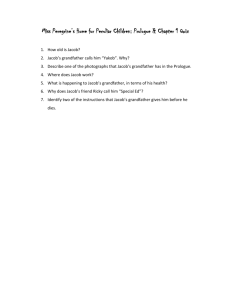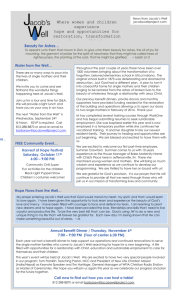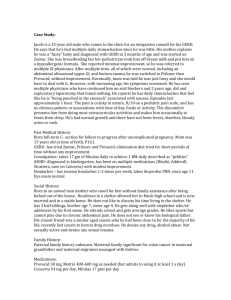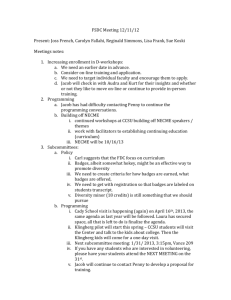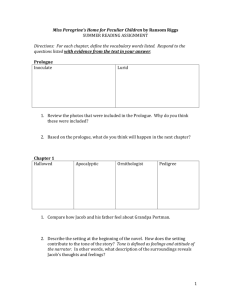"You Have Prevailed" - Gordon College Faculty
advertisement
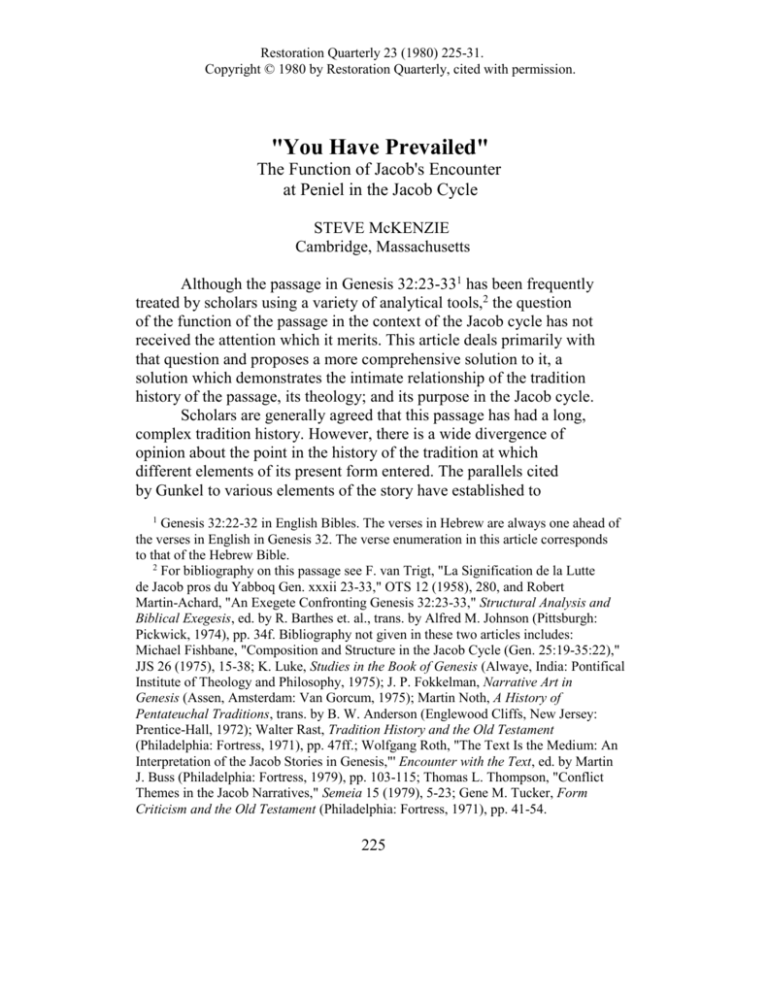
Restoration Quarterly 23 (1980) 225-31. Copyright © 1980 by Restoration Quarterly, cited with permission. "You Have Prevailed" The Function of Jacob's Encounter at Peniel in the Jacob Cycle STEVE McKENZIE Cambridge, Massachusetts Although the passage in Genesis 32:23-331 has been frequently treated by scholars using a variety of analytical tools,2 the question of the function of the passage in the context of the Jacob cycle has not received the attention which it merits. This article deals primarily with that question and proposes a more comprehensive solution to it, a solution which demonstrates the intimate relationship of the tradition history of the passage, its theology; and its purpose in the Jacob cycle. Scholars are generally agreed that this passage has had a long, complex tradition history. However, there is a wide divergence of opinion about the point in the history of the tradition at which different elements of its present form entered. The parallels cited by Gunkel to various elements of the story have established to 1 Genesis 32:22-32 in English Bibles. The verses in Hebrew are always one ahead of the verses in English in Genesis 32. The verse enumeration in this article corresponds to that of the Hebrew Bible. 2 For bibliography on this passage see F. van Trigt, "La Signification de la Lutte de Jacob pros du Yabboq Gen. xxxii 23-33," OTS 12 (1958), 280, and Robert Martin-Achard, "An Exegete Confronting Genesis 32:23-33," Structural Analysis and Biblical Exegesis, ed. by R. Barthes et. al., trans. by Alfred M. Johnson (Pittsburgh: Pickwick, 1974), pp. 34f. Bibliography not given in these two articles includes: Michael Fishbane, "Composition and Structure in the Jacob Cycle (Gen. 25:19-35:22)," JJS 26 (1975), 15-38; K. Luke, Studies in the Book of Genesis (Alwaye, India: Pontifical Institute of Theology and Philosophy, 1975); J. P. Fokkelman, Narrative Art in Genesis (Assen, Amsterdam: Van Gorcum, 1975); Martin Noth, A History of Pentateuchal Traditions, trans. by B. W. Anderson (Englewood Cliffs, New Jersey: Prentice-Hall, 1972); Walter Rast, Tradition History and the Old Testament (Philadelphia: Fortress, 1971), pp. 47ff.; Wolfgang Roth, "The Text Is the Medium: An Interpretation of the Jacob Stories in Genesis,"' Encounter with the Text, ed. by Martin J. Buss (Philadelphia: Fortress, 1979), pp. 103-115; Thomas L. Thompson, "Conflict Themes in the Jacob Narratives," Semeia 15 (1979), 5-23; Gene M. Tucker, Form Criticism and the Old Testament (Philadelphia: Fortress, 1971), pp. 41-54. 225 226 Restoration Quarterly a relative degree of certainty that those elements are ancient.3 The parallels include: 1) the attack by a deity, often a river god, upon a man; 2) the victory by the human hero over the deity and the extortion from the deity of some blessing or gift; 3) the fact that the deity roams only at night and must disappear at daybreak; 4) the reluctance of the deity to give his name as a result of the belief that to know a name is to have power over its bearer. It has been argued that the story was originally a Canaanite myth not associated with Jacob and probably not associated with Peniel.4 Although the story pattern is certainly ancient, the Israelite tradition cannot begin any earlier than the point at which Jacob is identified as the hero. There is little possibility of precise reconstruction earlier than this point. It is also relatively certain that the final element of the passage, the aetiology in verse 33, is late. It stands outside of the inclusio which encloses the story and adds no essential information to the story in terms of its purpose in the Jacob cycle as a whole. The earliest and latest elements of the passage, then, have been established to a relative degree of certainty. Scholars have proposed a number of reconstructions detailing the points at which the remaining elements of the present tradition entered. No one reconstruction is completely accepted, and it would be difficult to propose a reconstruction that is particularly new or convincing. Scholars have also pointed out a large number of the literary devices, especially word plays, contained within Genesis 32:23-33 and its immediate context.5 The words mahaneh, "camp," and minhah, "gift,” are important words in Genesis 32. The story of the place name, Mahanayim in 32:2f. anticipates the events narrated in the chapter. The reference to "two camps" seems to be deliberately ambiguous. Are the two camps Jacob's and Yahweh's, Jacob's and Esau's, or the two divisions of Jacob's caravan'?6 The verb 'abar, "to cross," also occurs frequently in this context (32:11, 17, 22, 23, 24; 33:3, 14), and statements using the verb form an inclusio around the narrative of Jacob's encounter with the 'elohim. The names ya’aqob and yabboq form a lovely word play with the verb ye’aqeb, "he wrestles," in verse 25. In fact, the two uses of the verb 'abaq with 3 Gunkel, HKAT, p. 361. Luke, pp. 121ff.; McKenzie, CBQ, 25, p. 73. 5 See especially, Schildenberger, Miscellanea Biblica B. Ubach, p. 80. 6 See the discussion of Fokkeiman, pp. 199ff. 4 McKenzie: "You Have Prevailed" 227 ‘immo, "with him," form a framework around the narration of the wrestling match itself in verses 25f. The noun panim, "face," occurs five times in verses 21f. and twice in 33:10, aside from its use in the Penuel/Peniel (vss. 31f.). Finally, the root nsl "to deliver," found in verse 31 is the same verb used in Jacob's prayer in verse 12. It is obvious that Genesis 32:23-33 represents a sophisticated literary piece with intricate connections with the passages which surround it. Some scholars have argued that the story in Genesis 32:23-33 is completely out of place, that it has nothing to do with the meeting of Jacob and Esau. Thus the passage is nothing more than a collection of aetiologies about the names Israel and Penuel/Peniel and the Israelite tradition against eating the sinew of the thigh. Noth is representative: ... the Penuel episode (Gen. 32:23-33 [J]), which is bound very firmly to a specific place, was inserted still later in a rather loose fashion and intrinsically has nothing at all to do with the narrative theme "Jacob and Esau." Rather, it is a distinctly separate narrative which originally was concerned with cultic matters and all sorts of etiological secondary interests.7 Elsewhere Noth refers to the passage as having an "infelicitous place in the midst of the story of Jacob's encounter with Esau."8 Others have argued that the narrative functions as an answer to Jacob's prayer in 32:10ff.9 Jacob knows that Esau will not harm him, because he has prevailed over a stronger opponent, the ‘elohim, from whom he has also extracted a blessing (vs. 29). Thus Jacob compares seeing the face of Esau, who has received Jacob favorably, with seeing the face of 'elohim (33:10). This understanding of the function of Genesis 32:23-33 is good as far as it goes, but it does not take into account the entire Jacob cycle and the significance of the story of Jacob's encounter at the Jabbok in relation to the themes which run throughout the Jacob cycle. Fishbane has attempted to deal with the entire Jacob cycle.10 He argues that the Jacob cycle (Gen. 25:19-35:22 according to Fishbane) consists of a chiasm. In general, Fishbane's scheme is quite correct, especially with regard to the narratives in Genesis 27-33. Genesis 27:17 Noth, p. 95. Noth, p. 7. 9 See especially Fokkelman, p. 220, who argues that the use of the root nsl in vs. 31 is a direct reference back to Jacob's prayer for deliverance in vs. 12, where nsl has been used. '° Fishbane, JJS, 28, pp. 15-38. 8 228 Restoration Quarterly 28:9 contains traditions about the competition between Jacob and Esau. Jacob's encounter with God and his angels is told in 28:10-22. In chapter 29 Jacob meets with Laban and is deceived by him, and 30:1-24 contains an interlude about the birth of Jacob's children. The material which then follows in 30:25---33:20 corresponds in reverse order to the material in 27:1---30:24. In 30:25-31:55, Jacob and Laban again rival one another. Chapter 32 tells of two encounters of Jacob with supernatural beings and of Jacob's preparations to meet Esau. The next chapter contains Jacob's meeting with Esau. The chiastic structure of the Jacob cycle is significant in terms of the theme and purpose of the cycle as a whole. At the structural center of the chiasm lies the story of the birth of Jacob's children, the founders and namesakes of the twelve tribes of Israel. As various scholars have observed, the individuals, Esau and Laban, here represent the political entities of Edom and Aram, respectively. The Jacob cycle tells how the nation of Israel, represented in its ancestors Jacob and his sons, contends with Edom and Aram, represented in their ancestors Esau and Laban. It further describes how Jacob/Israel prevailed over all opponents and gained control of the land. The specifying of the children of Jacob, the fathers of the tribes of Israel, lies at the center of the narrative both structurally and functionally. The Jacob cycle is the story of the perseverance and prevalence of Israel. The narrative in Genesis 32:23-33 corresponds to the theophany in 28:10-22 thus filling a needed link in the chiastic structure. But it also serves a much more important function. Throughout the Jacob cycle three themes predominate: strife, deception, and blessing. Before their birth, Jacob and Esau struggle within the womb of their mother (Gen. 25:22). Jacob is born holding onto the heel of Esau (25:26). His name, "Jacob," characterizes him both as a fighter ("heel-grabber") and as a deceiver ("supplanter"; cf. 27:36). Jacob deceives Esau into trading his birthright (bekorah, 25:29ff.) and then deceives his father, Isaac, into granting the blessing (berekah) to him instead of Esau (27:5-45). Jacob's dealings with Laban are also seen as a struggle. Laban strikes first, deceiving Jacob by giving him Leah instead of Rachel (29:15-30).11 Yahweh blesses Laban on Jacob's account so 11 The irony here deserves comment. In the case of Jacob and Esau, the younger brother is favored, and the older serves the younger. Now, Jacob is appropriately deceived into marrying the older sister, Leah, first rather than the younger, Rachel, for whom he has worked. McKenzie: "You Have Prevailed" 229 that Laban is reluctant to release Jacob (30:27). Jacob reciprocates by deceiving Laban (30:27-31:16). Again, God blesses Jacob so that he becomes wealthy in spite of Laban's deceptions (31:5ff.). Laban accuses Jacob of deceiving (31:27). He comes apparently to fight with Jacob, but God protects Jacob and warns Laban against doing him harm (31:24, 29ff.). Even Rachel deceives her father by stealing the household gods (31:33ff.). Jacob responds to Laban's accusations with his own complaints that Laban has deceived him by changing his wages numerous times, but God has thwarted Laban's attempts by blessing Jacob and protecting him (31:36-42). Finally, the encounter with Esau is feared by Jacob because of Esau's superior strength in battle (32:7). Even here Jacob acts craftily in the arrangement of his caravan and in sending a train of gifts to Esau (32:7, 14ff.). The Jacob cycle ends with a reiteration of the promise of blessing for Jacob (35:9-15). These themes of strife, deceit, and blessing come to a climax in the narrative of Genesis 32:23-33. Jacob now faces the most difficult conflict of his life, because his opponent is no longer simply a man, but ‘elohim. Deception is involved in the struggle when the opponent apparently employs a trick of fighting to put Jacob's thigh out of joint.12 Jacob receives the most important blessing of his life in the change of his name to Israel. The climactic verse is verse 29. Jacob's name is changed to Israel, because he has prevailed in his struggles with human as well as divine. The narrative which follows about Jacob's meeting with Esau helps to fill out the chiastic structure of the Jacob cycle, but it is clearly anticlimactic. Jacob has persevered. Assuredly, he will not come to harm or defeat at the hands of Esau. He has prevailed and is supremely blessed. It is important to recall at this point that the Jacob cycle, according to those who follow standard source analysis, is really the story of 12 Gunkel, HKAT, p. 361, argued that the original story had Jacob using a trick of fighting to injure the opponent. This would be better in line with the comparative material in which the human tricks the deity into defeat. It also fits well the character of Jacob as a deceiver in the Jacob cycle. But it is difficult to see why the original story would be altered at this point, unless the change came about merely by confusion (note the confusing use of pronouns in vs. 25a to denote subjects and objects). At any rate, if such a confusion did occur, it clearly took place before the incorporation of the story into the Yahwistic Epic and thus does not alter the Yahwist's theology or the importance which he gives to the story. 230 Restoration Quarterly the nation Israel.13 The point made by the writer is that the nation of Israel has prevailed, prevailed over all opponents, not just Edom and Aram. This theological point indicates that the Jacob cycle in its present form stems largely from a time when the nation of Israel could identify with the patriarch as having come out of all its struggles as victor. This notion accords well with the conditions of Israel during the Davidic and early Solomonic age, the era in which the Yahwistic Epic is usually dated.14 Most of the Jacob cycle is, in fact, attributed to the Yahwist.15 Thus, the Yahwist, writing during the era of Israel's greatest supremacy, describes the nation through the life story of the patriarch Jacob/Israel. The Yahwist describes his nation, like its ancestor, as having acquired the blessing of Yahweh, as a result of which they have endured against all their opponents, and have become preeminent.16 Yahweh's covenant with Abraham and his promise to bless the patriarch, linked in Yahwistic material with, Yahweh's 13 Despite the lack of scholarly consensus in regard to details, Wellhausen's classical formulation of the documentary hypothesis remains the standard approach to the Tetrateuch (Genesis-Numbers). Brevard Childs has observed: "Of more influence-on the history of scholarship was the work of scholars who continued to operate within Wellhausen's general framework but sought further to refine the sources. In the course of the refinement important weaknesses emerged which often unintentionally began to dissolve the reigning consensus. . . Long after the early confidence in the classic documentary theory had disappeared, critical scholars continued to work with Wellhausen's source analysis largely because of the lack of any new consensus by which to replace it." Introduction to the Old Testament as Scripture (Philadelphia: Fortress Press, 1979) p. 114. F. M. Cross has offered a significant modification of the documentary hypothesis. He prefers to speak of J and E as variant prose forms of a single, older Epic cycle. He also holds that P was never a separate source, but only the post-exilic editor of the Epic traditions. Cross' view is important for understanding the purpose of the story in Gen. 32:23-33 in the various levels of tradition. See Cross' discussion in his Canaanite Myth and Hebrew Epic (Cambridge: Harvard Univ. Press, 1979), pp. 293-325. 14 F. M. Cross, Canaanite Myth, pp. ix, 124, 263ff., 293. 15 Most of the Jacob cycle is J material. There are sections which can only be characterized as Epic material, that is, J and E combined. P material exists in the Jacob cycle, but it is not common. Material generally attributed to P is: 25:19f.; 26:34f.; 27:46-28:9; 31:18b; 35:9-13, 15, 22b-29. 16 I have referred to Jacob's opponent throughout simply as 'elohim. It is a common notion among scholars that the Yahwist identified the opponent with Yahweh, but I am not convinced that this was the case. The name Yahweh is never mentioned in 32:23-33. It also seems unlikely that J would have accepted the idea that Yahweh was defeated by a human. It seems more likely that J has inherited a tradition about Jacob defeating a minor deity and that J has remained faithful to the language of the older tradition, though he may not have understood it (cf. Hos. 12:4f., where the opponent is seen as an angel, and 'elohim and mal’ak, "angel," are found in parallel. The el element in the names 'Israel' and 'Peniel' can clearly be used as a generic appellative (see Cross, Canaanite Myth, pp. 45ff.). McKenzie: "You Have Prevailed" 231 covenant with and blessing of David, has been observed and discussed by various scholars.17 In the Jacob story the Yahwist provides a similar link between the patriarchs, especially Jacob, and the Davidic kingdom. The blessing of Yahweh over Jacob brings about his prevalence over all opponents, his safe return to Canaan, and his establishment in the land. The blessing of Yahweh over the nation of Israel results in their successful return to Canaan from Egypt and, under David, their victory over all enemies and hegemony over the entire land promised to the patriarchs. For the Yahwist, Israel's blessing under David is foreshadowed in Yahweh's blessing of Jacob. In editing the Epic sources, J and E, the Priestly tradent(s) attached another meaning to the Jacob cycle, one that communicated a message relevant to the Israel of his time. The P school probably edited the Epic sources in the Tetrateuch in the sixth century B.C., when Israel was in Babylonian exile.18 The present chiastic arrangement of the narratives in the Jacob cycle is possibly the result of the editorial work of P. At any rate, for the Priestly tradent(s) also the nation of Israel was embodied in the patriarch Jacob. The major importance of the Jacob story for P was in the return of Jacob to the land of Canaan. In Jacob, P saw the hope that exiled Israel would also return to the land of their heritage and again prevail over their opponents.19 17 Cross, pp. 323ff3 and Ronald E. Clements, Abraham and David (Naperville, Indiana: Alec R. Allenson, 1967), pp. 47-60. 18 See Cross, pp. 293-325. 19 For P, this tradition must have posed difficult theological problems. Since P was monotheistic, Jacob's opponent could not have been another deity. The opponent could have been understood as an angel of Yahweh, but for P, e1 consistently refers to Yahweh (Cross, p. 46). Also, for P, this tradition about Jacob's struggle with God and particularly the name `Israel' were truly representative of the nation's character and history. Israel's continual struggles with God had resulted in their exile in Babylon. Thus, in contrast to J, P took a negative view of the tenacity common to the patriarch and the nation of Israel. Yahweh's blessing of Jacob and returning him to Canaan in spite of himself furnished P's hope that God would deal similarly with Jacob's descendants. This material is cited with gracious permission from: Restoration Quarterly Corporation P. O. Box 28227 Abilene, TX 79699-8227 www.restorationquarterly.org Please report any errors to Ted Hildebrandt at: thildebrandt@gordon.edu
